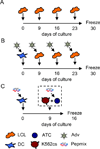Adoptive T-Cell Immunotherapy
- PMID: 26428384
- PMCID: PMC4655436
- DOI: 10.1007/978-3-319-22834-1_15
Adoptive T-Cell Immunotherapy
Abstract
Epstein-Barr virus (EBV) is associated with a range of malignancies involving B cells, T cells, natural killer (NK) cells, epithelial cells, and smooth muscle. All of these are associated with the latent life cycles of EBV, but the pattern of latency-associated viral antigens expressed in tumor cells depends on the type of tumor. EBV-specific T cells (EBVSTs) have been explored as prophylaxis and therapy for EBV-associated malignancies for more than two decades. EBVSTs have been most successful as prophylaxis and therapy for post-transplant lymphoproliferative disease (PTLD) , which expresses the full array of latent EBV antigens (type 3 latency), in hematopoietic stem-cell transplant (HSCT) recipients. While less effective, clinical studies have also demonstrated their therapeutic potential for PTLD post-solid organ transplant and for EBV-associated malignancies such as Hodgkin's lymphoma, non-Hodgkin's lymphoma, and nasopharyngeal carcinoma (NPC) that express a limited array of latent EBV antigens (type 2 latency). Several approaches are actively being pursued to improve the antitumor activity of EBVSTs including activation and expansion of T cells specific for the EBV antigens expressed in type 2 latency, genetic approaches to render EBVSTs resistant to the immunosuppressive tumor environment, and combination approaches with other immune-modulating modalities. Given the recent advances and renewed interest in cell therapy, we hope that EBVSTs will become an integral part of our treatment armamentarium against EBV-positive malignancies in the near-future.
Keywords: Cancer; EBV; Gene transfer; Immunotherapy; T‐Cell therapy.
Figures



References
Publication types
MeSH terms
Grants and funding
LinkOut - more resources
Full Text Sources
Other Literature Sources

